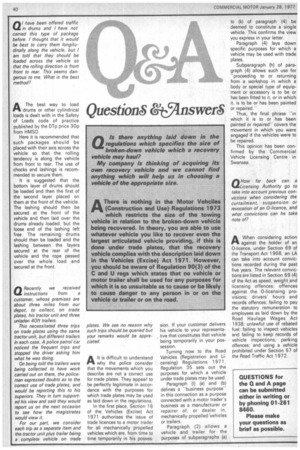Q Recently we received
Page 44

If you've noticed an error in this article please click here to report it so we can fix it.
instructions from a customer, whose premises are about three miles from our depot, to collect, on trade plates, his tractor unit and three unladen 40ft trailers.
This necessitated three trips on trade plates using the same tractor unit, but different trailers in each case. A police patrol car noticed the frequent trips and stopped the driver asking him what he was doing.
On being told the trailers were being collected to have work carried out on them, the policeman expressed doubts as to the correct use of trade plates, and would be reporting this to his superiors. They in turn supported his view and said they would report us on the next occasion to see how the magistrates would view it.
For our part, we consider each trip as a separate item and the tractor unit plus trailer being a complete vehicle on trade plates. We see no reason why such trips should be queried but your remarks would be appreciated.
Ait is difficult to understand why the police consider that the movements which you describe are not a correct use for trade plates. They appeal' to be perfectly legitimate in accordance with the purposes for which trade plates may be used as laid down in the regulations.
In the first place, Section 16 of the Vehicles (Excise) Act 1971 authorises the issue of trade licences to a motor trader for all mechanically propelled vehicles which are, from time to time temporarily in his posses sion. If your customer delivers his vehicle to your representative that constitutes that vehicle being temporarily in your possession.
Turning now to the Road Vehicles (Registration and Licensing) Regulations 1971, Regulation 35 sets out the purposes for which a vehicle under trade plates may be used.
Paragraph (I) (a) and (b) defines a "business purpose" in this connection as a purpose connected with a motor trader's business as a manufacturer or repairer of, or dealer in, mechanically propelled 'vehicles or trailers.
Paragraph (2) allows a vehicle and trailer for the purposes of subparagraphs (a) to (k) of paragraph (4) be deemed to constitute a single vehicle. This confirms the view you express in your letter.
Paragraph (4) lays down specific purposes for which a vehicle may be used with trade plates.
Subparagraph (h) of paragraph (4) allows such use for "proceeding to or returning from a workshop in which a body or special type of equipment or accessory is to be or has been fitted to it, or in which it, is to be or has been painted or repaired ."
Thus, the final phrase "in which it is to or has been painted or repaired" covers the movement in which you were engaged if the vehicles were to be repaired.
This opinion has been confirmed by the Commercial Vehicle Licensing Centre in Swansea.


































































































